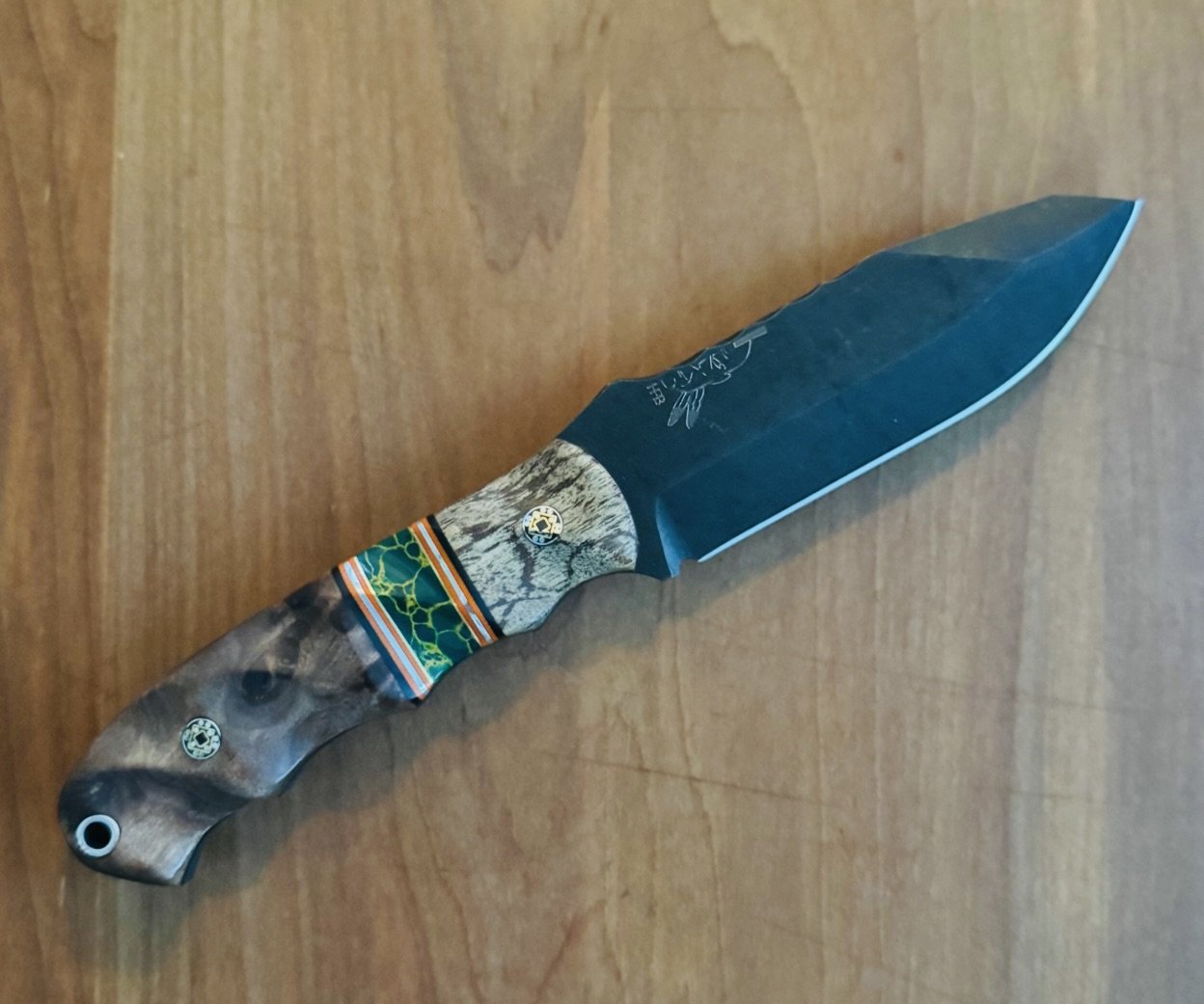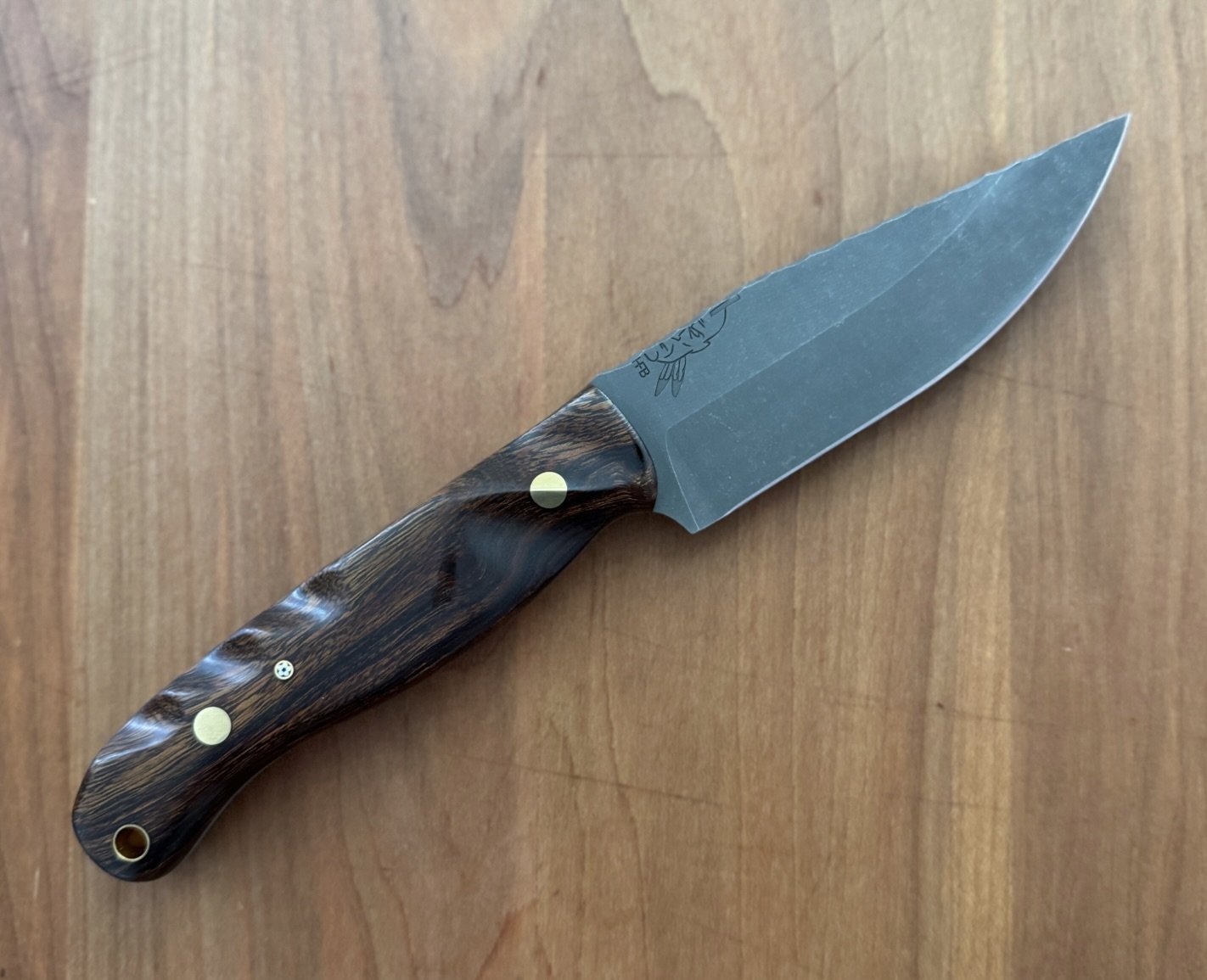Split Scales: The Signature of Half Face Blades
One of the most identifiable traits of Half Face Blades is their innovative and creative use of varied materials for their handle scales, particularly the unique split scale options. It’s a feature that makes the knives instantly recognizable to those familiar with the brand. Founded by former Navy SEAL Andrew Arrabito, HFB has earned a strong reputation for producing high-end, handcrafted knives and tools. The split scale construction is a standout characteristic of the brand’s designs, and is featured on many of their premium fixed blades.
What Are Split Scales?
Split scales refer to handle scales, typically made from durable materials such as G10, antler, bone or hardwoods, that feature a design divided into two or more distinct materials or colors on each side of the knife handle. These scales are not two separate slabs attached side by side; each side consists of one continuous scale that is intentionally “split”. This design technique combines contrasting materials to create a visually striking and unique handle appearance, while maintaining structural integrity.
Split Scales are appealing for several reasons:
Aesthetic Appeal: The multiple-material design is visually striking and has become signature look for many HFB knives.
Grip: The use of different materials often provides varied textures, which can enhance grip and control, particularly important in tactical or hunting/outdoor situations where a secure hold is crucial.
Custom Feel: Each knife feels unique. Many HFB split scale models are produced as limited runs, and the variations in materials such as ironwood, bone, or G10 contribute to making each piece distinct and personal.
Below, we take a closer look at the various materials commonly featured in their unique handle designs, and the qualities that make each one stand out:
Synthetic Materials
Synthetic materials used are chosen for their toughness, stability, and excellent grip in adverse conditions. These are more standard materials used throughout the industry.
G10: A high-pressure fiberglass laminate, produced by layering multiple sheets of fiberglass cloth that have been soaked in epoxy resin. This process results in a material that is exceptionally strong and reliable. G10 is lightweight yet sturdy, offering a firm, grippy texture that enhances handling. It is completely impervious to moisture, making it ideal for use in wet or humid conditions; and it is highly durable, capable of withstanding wear and tear over time.
Micarta: A durable composite material made from layers of linen, canvas, paper, or burlap that are infused with resin. Known for its excellent grip even when wet, an aesthetically pleasing textured surface, and a natural feel that has a vintage look. Micarta often develops subtle variations and a unique patina over time, enhancing its character with use.
Carbon Fiber: A lightweight composite material made from numerous carbon strands woven together and embedded in a durable resin matrix. Known for being exceptionally light while maintaining strength, it offers a sleek appearance often described as more refined or tactical in style. Variants include several types such as twill, forged carbon, and marbled carbon fiber, each providing unique visual patterns.
Natural Materials
These add a unique, handcrafted touch and are often favored for their nice feel in hand and aesthetics.
Ironwood (Desert Ironwood): A dense, oily hardwood featuring a combination of rich brown and shimmering gold grain patterns. Ironwood is very stable and highly resistant to warping, cracking, or other common forms of damage.
Burl Woods: Known for their distinctive swirling, irregular grain patterns, which make each scale truly unique. These woods are often stabilized, meaning they are impregnated with resin to enhance their strength and durability.
Bone / Antler: These are durable, natural, and richly textured. Bone and antler materials offer a timeless look and are very popular.
These materials are more commonly found in traditional looking knives or smaller, limited production runs. They are often paired with synthetic materials like Micarta or G10 to create a distinct contrast in both appearance and texture.
Metal & Exotic Combos
HFB also incorporates metals or hybrid materials for their split scales.
Brass and copper Inserts: Commonly used as inlays or decorative accents, providing a distinctive look. These materials not only add some additional character to the knife, but also develop a unique patina over time, creating nice visual appeal.
Fat Carbon / Custom Laminates: These are carefully crafted layered materials that combine resin with metal flakes or dyed fibers, creating a nice visual effect.
Why Split Scales Work
The contrast of synthetic and natural materials (for example, sleek black G10 combined with rich, warm ironwood) gives each knife a unique appeal, a perfect representation of Half Face Blades’ core ethos: creating highly functional, purpose-driven tools created through experience in the field and built with the dedication of skilled craftsman.
These blends not only enhance the knife’s overall performance and durability, but leans into the artistry, heritage, and bladesmithing tradition found in every HFB knife.


